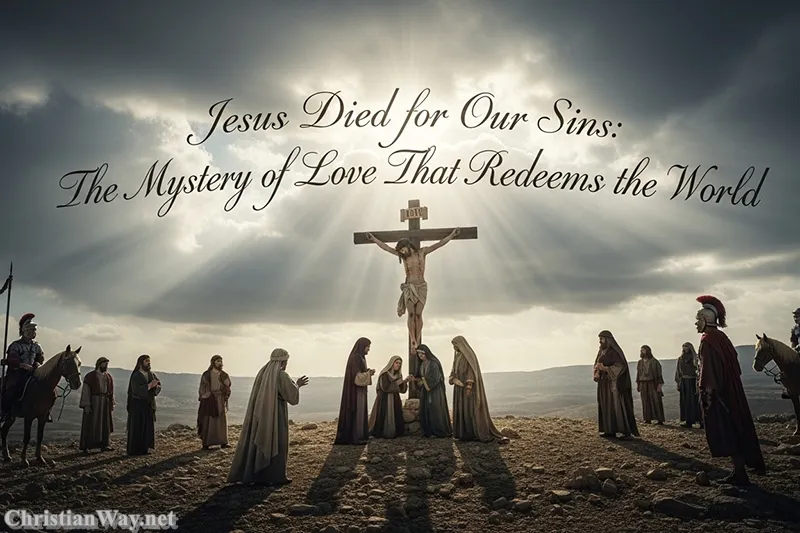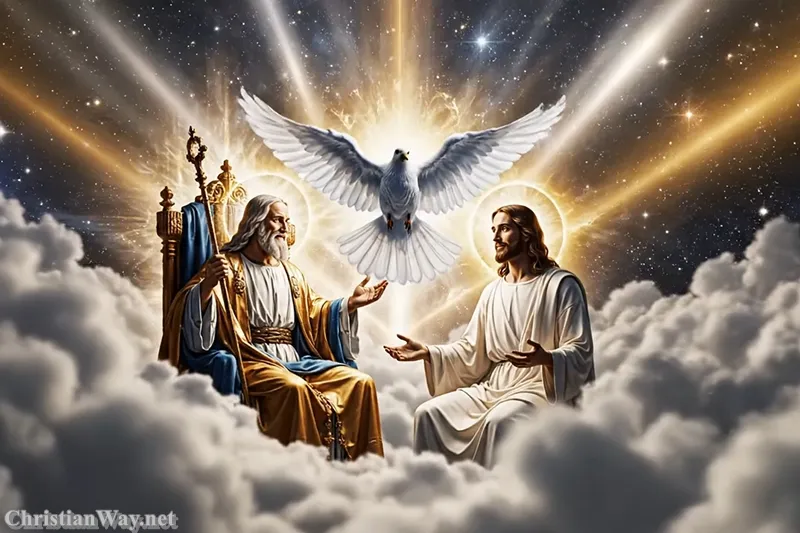Dear friends in Christ,
There is a sacred stillness that follows Easter morning — a silence filled not with absence, but with promise. After the risen Lord had walked among His disciples for forty days, teaching, consoling, and revealing the fullness of God’s plan, He led them to a hill outside Jerusalem. There, in a moment beyond words, Jesus Christ lifted His hands in blessing and was taken up into Heaven. The clouds received Him from their sight, but His presence did not leave the world.
The Ascension of Jesus is not the conclusion of His story, but the crowning of His mission. It is the return of divine love to its eternal home — yet carrying within it the redeemed humanity of Christ. In that moment, heaven and earth were forever joined. What began in the manger of Bethlehem, what was revealed in the Cross and Resurrection, now reaches its glorious fulfillment: the Son of God returns to the Father, and in Him, our humanity is lifted into the life of God.

Let us walk together through this mystery — not as spectators of a distant event, but as those invited to share in its power. For the Ascension of Jesus is the great bridge between the visible and the invisible, the earthly and the divine, the now and the eternal.
The Forty Days After the Resurrection
After His glorious Resurrection, Jesus did not immediately return to the Father. Scripture tells us, “He presented Himself alive to them after His suffering by many proofs, appearing to them during forty days and speaking about the kingdom of God” (Acts 1:3).
These forty days were days of formation — a time when the disciples’ fear was turned into faith. Jesus appeared to them in their doubt, in their meals, in their questions. He showed them His wounds and broke bread with them. He restored Peter, comforted Mary, and revealed to Thomas that faith is born not only from sight, but from trust.
He taught them that His Kingdom is not of this world, yet it transforms this world from within. He revealed that the mission of salvation would now continue through His Church, guided by the Holy Spirit.
Every word and gesture of these forty days prepared them — and us — for the Ascension. Christ’s departure was not abandonment; it was empowerment. He would no longer walk beside them in the flesh, but He would dwell within them in Spirit.
The Moment of Ascension
The Acts of the Apostles describes the moment simply, yet profoundly:
“As they were looking on, He was lifted up, and a cloud took Him out of their sight. And while they were gazing into heaven as He went, behold, two men stood by them in white robes and said, ‘Men of Galilee, why do you stand looking into heaven? This Jesus, who was taken up from you into heaven, will come in the same way as you saw Him go into heaven’” (Acts 1:9–11).
In this single passage, heaven and earth speak to one another. The disciples look upward in wonder, yet angels remind them that their mission is not to remain staring into the sky, but to bring the message of Christ to the world.
The Ascension of Jesus was not a disappearance, but a transformation of presence. Christ does not go away — He goes beyond. He ascends not to distance Himself, but to fill all things with His divine life. As Saint Paul writes, “He who descended is the one who also ascended far above all the heavens, that He might fill all things” (Ephesians 4:10).
Christ’s Ascension marks the beginning of His reign at the right hand of the Father — the place of authority, intercession, and love. It is from there that He pours out the Holy Spirit upon the Church and continues to guide His people through the ages.
What the Ascension Reveals About Jesus Christ
The Completion of His Mission
The Incarnation began with descent — the Son of God coming down to dwell among us. The Ascension completes that descent by lifting humanity back into communion with God. As the Catechism teaches, “Jesus Christ, the head of the Church, precedes us into the Father’s glorious kingdom so that we, the members of His Body, may live in the hope of one day being with Him forever” (CCC 666).
In Christ, our human nature — once fallen, now redeemed — enters heaven. For the first time, a human heart beats in the eternal life of God. The Ascension of Jesus therefore affirms our destiny: we were not created for the dust, but for glory.
The Beginning of His Heavenly Intercession
Saint Paul tells us that Christ “is at the right hand of God and intercedes for us” (Romans 8:34). In heaven, Jesus does not rest in passive glory — He continues His saving work through prayer and mercy. Every wound He bore for love of us remains a sign of His eternal compassion.
From His throne of grace, the Lord Jesus Christ becomes the eternal High Priest, presenting our prayers to the Father. Every sigh of sorrow, every cry for help, every act of faith — He gathers and offers them in love.
The Promise of His Return
The angels’ message at the Ascension echoes through history: “This Jesus will come again.” The Ascension is not the end, but the beginning of waiting — a waiting filled with mission and hope. It is the pledge that history is moving toward fulfillment, that Christ will one day return in glory to judge the living and the dead.
Until then, He reigns invisibly, guiding the world through the Spirit, the Word, and the Sacraments. His absence is not emptiness; it is space for faith to grow.
The Ascension and the Holy Spirit
Jesus told His disciples, “It is to your advantage that I go away, for if I do not go away, the Helper will not come to you” (John 16:7). The Ascension of Jesus is therefore directly linked to the coming of the Holy Spirit at Pentecost.
By ascending, Christ opens the way for the Spirit to descend. The Spirit becomes the breath of the Church, empowering her to continue the mission of Christ on earth.
When Jesus returned to the Father, He did not leave us orphans. The Holy Spirit makes His presence alive in our hearts, in the Eucharist, in the Scriptures, and in the communion of believers. Through the Spirit, Christ remains nearer to us than ever before.
Heaven: Our True Home
The Ascension reminds us that this world, beautiful though it is, is not our final home. “Our citizenship is in heaven,” writes Saint Paul, “and from it we await a Savior, the Lord Jesus Christ” (Philippians 3:20).
When Christ ascended, He carried our humanity with Him. This means that heaven is not an abstract realm of spirits; it is a place prepared for us — a home where the Risen Lord waits with open arms.
Every sorrow endured in faith, every act of love, every offering of forgiveness becomes a step toward that heavenly dwelling. The Ascension fills the Christian life with direction: we are not wandering souls; we are pilgrims moving toward union with God.
Living the Mystery of the Ascension
1. Hope in the Midst of Absence
Like the disciples, we may sometimes feel that Christ is far away. But faith teaches us that His presence is no longer limited to time and place. When we pray, when we love, when we serve the least among us — Christ is there.
The Ascension transforms absence into sacramental presence. We meet Him not by reaching up into the clouds, but by lowering ourselves in humility and charity.
2. Mission in the Midst of Waiting
The angels’ words — “Why do you stand looking into heaven?” — remind us that the Christian life is active. We await Christ’s return not in passivity but in witness.
To live the Ascension of Jesus is to proclaim through our lives that He reigns. It is to make the Kingdom visible in acts of justice, mercy, and faith. Every act of love is a continuation of His ascent — for when we lift others up, we share in His rising.
3. Prayer in the Midst of the World
Our prayer becomes a bridge between earth and heaven. Each time we lift our hearts to God, we join Christ in His eternal offering. The liturgy, especially the Mass, is the living memory of the Ascension — where heaven and earth unite in worship.
In every Eucharist, the priest proclaims: “Lift up your hearts.” And we respond, “We lift them up to the Lord.” This is the rhythm of the Ascension — the continual raising of our lives into divine love.
Witnesses of the Ascension
The Church Fathers saw the Ascension not as separation, but as exaltation. Saint Augustine wrote, “He departed from us, and yet He is with us; He has gone away, and yet He has not left us.”
Saint Leo the Great added, “What was visible in our Redeemer has passed into the Sacraments.” That is to say, the visible presence of Jesus in Galilee now becomes a mystical presence in the Church.
The apostles, once timid, became bold after witnessing this glory. They returned to Jerusalem with great joy, for they knew that Christ’s reign was not ended but magnified. This joy remains the heartbeat of the Church today.
The Ascension in Christian Art and Worship
From the earliest centuries, artists have depicted the Ascension of Jesus as a moment of light and majesty — Christ rising above the Mount of Olives, surrounded by angels, blessing His apostles below. Yet even in these images, the focus is not on distance, but on connection. His hands remain extended, as if still blessing the world He loves.
In the liturgical calendar, the Ascension is celebrated forty days after Easter — traditionally on a Thursday, though often moved to the following Sunday in many churches. The readings remind us that this is not only an event of the past but a reality shaping our present hope.
When the priest incenses the altar and the Gospel is lifted high, we glimpse the rhythm of heaven — the same upward motion that began on the Mount of Olives. The Church’s every act of worship participates in that eternal ascent.
The Ascension and the Unity of the Church
The mystery of the Ascension calls every branch of Christianity — Catholic, Orthodox, Anglican, and Protestant — to unity in the risen and ascended Lord.
Though we may differ in expression, we share one faith in Jesus Christ who ascended for all, intercedes for all, and will return for all. The Church on earth and the Church in heaven are not two separate realities but one communion in Christ’s love.
As the Lord said, “And I, when I am lifted up from the earth, will draw all people to Myself” (John 12:32). That promise continues in the Ascension — the promise that no one is beyond His reach.
Reflect and Pray
Dear brothers and sisters, the Ascension of Jesus Christ is not only a feast to be remembered; it is a reality to be lived. It teaches us to look upward without losing sight of the world, to love heaven without neglecting earth, to hope for glory while serving humbly.
Let our hearts ascend with Christ in every act of faith, in every prayer whispered amid trial, in every moment of love offered for another.
Prayer:
Lord Jesus Christ, risen and ascended Savior,
You returned to the Father not to leave us, but to prepare a place for us.
Lift our hearts above the weight of this world,
that we may seek the things that are above, where You reign in glory.
Fill us with the joy of Your presence, and send us forth as witnesses of Your Kingdom.
May our lives reflect Your love until the day You return in majesty.
Amen.
— Fr. John Matthew, for Christian Way





